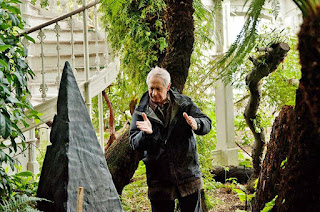Nash began his talk by citing the two bodies of literature which had had the greatest impact on his life and art; these were the works of Henry Miller and the Tao Te Ching. He decided shortly after his art degree that the most important goal in his life was to be a “free person.” That mattered even more to him than being an artist. He explained that to fulfil this purpose, he realised that it would be necessary to live with “low overheads.” He therefore moved to a remote part of north Wales, eventually buying an empty Methodist church for use as a studio. And he’s been there ever since. In keeping with this low-cost lifestyle, he began using materials that he could forage or scavenge and finally settled on discarded or fallen trees. And boy, does this man know his trees. He knows about the different species, their ecosystems and how they grow as well as how they age, die and decompose. It was really fascinating to hear all this, not from a botanist, but from an artist.
He sprinkled his talk with notions echoing what I’ve read
about in eastern philosophy. For
example, he said that he’s never applied or asked for his work to be exhibited;
rather, he’s always waited to be invited (very tao, that). One of his most famous works, for example, was
an enormous wooden boulder which he’d intended to push down a waterfall in
order to photograph its splash, after which he’d intended to display it with
his collection. After a mishap in the
pushing and falling of the ‘boulder’ he allowed it to make its way downstream,
getting lodged here and there along its way over the course of many years. At one point, he said that rather than trying
to retrieve the art from the river as originally planned, he asked the boulder
what it wanted to do; this resulted
in Nash "letting the boulder go". He
thinks that the boulder has now gone out to sea and there haven’t been any
sightings of it in a long time.
Other eastern references included feng shui, our
human part of gaia earth, the Gertian approach to morality and what he called
“the physicality of energy.” Nash didn’t
expand on any of these ideas, but I could certainly sense that his thinking and
work were largely informed by an eastern monistic worldview. He said that he brought his spirituality to
wood and this was evidenced in the amount of time, energy and effort he
invested in its transformation. Nash explained
that artifacts, even if they appear mundane, can become infused with potency
and impregnated with meaning by the associations we give them. He gave the example
of someone giving him a branch, then telling him it’s an olive branch –
suddenly more meaning – then telling him him it’s from Galilee – even more
significant.
He contrasted his work with that of Caro – the artist who pioneered the idea of assembling a sculpture by using metal objects he 'found along the way', so to speak. I sense that Nash see himself to be much closer to nature and his work more imbued with a sense of flow – he called some of his work ‘coming’ (e.g. live trees he’s planted in certain formations) and others ‘going’ – pieces that which would eventually decay completely and return to the earth. However, he did admit to having a bit of a ‘Bob Dylan’ moment, when he decided to cast some of his sculptures in bronze for preservation purposes; this would enable them to be more than photographic legacies and allow them to withstand the elements in natural settings.
I don’t agree that ultimate reality is revealed to us in the Tao de Ching, nor that true spirituality is to be found in panentheism, as David Nash does. But I do, however, appreciate his work more now than I did before the lecture. This is because I believe that one can understand a work of art better if one knows something about the artist who made it and also that one can understand the artist better by knowing something about the development of their worldview, their beliefs and where they put their functional trust. I think art appreciation is less about ‘liking’ a work of art and rather more about understanding where it’s come from and what it represents.






No comments:
Post a Comment